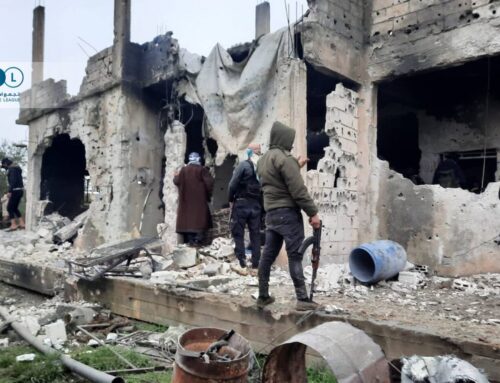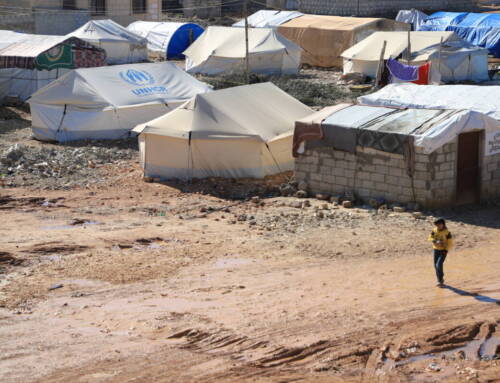Regime sniper’s bullet hits Madaya man, who bleeds to death amid stranglehold on encircled town
Mohammad al-Mowwil was walking to his home in regime-encircled Madaya […]
25 October 2016
Mohammad al-Mowwil was walking to his home in regime-encircled Madaya on Saturday when a sniper’s bullet pierced his abdomen. The bullet tore through his intestines before shattering his pelvis, leaving the 30-year-old father in excruciating pain as he bled out.
Two days later, he was dead.
“There was nothing we could do,” Mohammad Darwish, a former dental student and one of Madaya’s last remaining medical professionals, tells Syria Direct’s Bahira al-Zarier. “We didn’t have the right medical supplies or equipment,” he says, “and we lack any kind of specialist who knows how to perform surgery for serious injuries.”
Regime and allied Hezbollah forces surrounded Outer Damascus’ Madaya more than a year ago, leaving the former mountain resort’s 40,000 residents trapped, starving, inside.
Thousands of landmines and at least 65 regime checkpoints manned by snipers surround the town, ensuring that whoever tries to leave—or, in Mohammad al-Mowwil’s case, whoever’s house sits close to a checkpoint—risks death.
At least 20 Madaya residents have been killed by snipers and landmines throughout the siege, according to a July 2016 report by Physicians for Human Rights.
Those who survive are in the hands of Madaya’s three remaining medical professionals—two dentists and a veterinarian. When, as in a-Mowwal’s case, a patient requires knowledge beyond their limited expertise, the three use the internet to connect with specialists in rebel-held Syria or beyond in order to advise them.
This time, Skype wasn’t enough. “They told us we needed to get him outside Madaya within 24 hours,” says Darwish. “Even then, they said a specialist would be unable to help him, except to keep him alive for a little while longer.”
Trapped inside Madaya, al-Mowwil suffered nearly three days of intense pain, including, Darwish says, a seven-hour surgery, before the town’s medical committee announced his death on Monday morning.
Q: How did Mohamad al-Mowwil die?
The bullet that hit him caused a lot of damage. It cut through both his large and small intestines, broke his pelvis and caused unstoppable bleeding.
We didn’t have the right medical supplies or equipment to operate on him, and the oxygen supply ran out during the first 10 minutes of surgery. His surgery lasted seven hours, and we had to use a hand-operated ventilator to help him breathe.
But the main reason he died was because we lack any kind of specialist who knows how to perform surgery for serious injuries.
At the end of the day, we are just two dentists and a veterinarian.

Q: How old was Mohammad al-Mowwil? How has his family reacted to his death?
He was 30 years old, with a wife and children. When we broke the news to his family, we told them that we were not responsible for his death.
They signed an affidavit saying that he could undergo surgery, because they knew he was going to die anyway, even if he was allowed to leave Madaya.
Q: Did you communicate with any doctors outside Madaya while performing the operation?
I coordinate with doctors from the north, namely Idlib and Aleppo. Those specialists were helping us with this operation, and, thank God, they are there for us in the most urgent situations.
[In al-Mowwil’s case], we spoke via Skype with specialists outside Madaya, and they said that the most important thing was for us to just keep him alive, because there was nothing we could do. They told us we needed to get him outside Madaya within 24 hours.When we sent pictures to the specialists of the damage in al-Mowwil’s abdomen, they told us he would need a more specialized doctor. Even then, they said a specialist would be unable to help him, except to keep him alive for a little while longer.
Q: As the doctor in charge of this situation, how have you personally reacted to al-Mowwil’s death?
I’m never able to describe how I feel in these situations. I feel worthless and discouraged because of the lack of medical supplies and necessary expertise.
The situation inside Madaya is extremely tragic, and there are no words to describe it. It is very hard for us to perform surgery with only three doctors on hand.
Q: How many medical cases in Madaya require evacuation because the required medical services or expertise are not available inside the city?
It’s hard to give you an exact number of urgent cases that require immediate evacuation. We were hovering around 30 cases, but that increased by 10 recently. And for every day that we get 10 people out, another 20 will come in needing care. But the situation is incredibly complex and dynamic. Just yesterday, a patient came to us complaining of kidney failure, quite similar to the case of Ali Ghussun.
Q: Why did the regime refuse to let al-Mowwil go outside Madaya for medical treatment?
Regime forces recently allowed 40 high school students to leave Madaya for their exams, and they still haven’t come home. The regime did this without cooperating with regime forces, who have besieged Kafariya and al-Fuaa, two mainly Shiite towns in Idlib province.
[Ed. Note: Kafariya and al-Fuaa are part of a deal between rebel and regime forces governing the movement of civilians from two pairs of besieged towns: regime-encircled Madaya and Zabadani in outer Damascus, and opposition-encircled Kafariya and al-Fuaa in Idlib]The regime has said that since the Madaya students haven’t returned yet, 40 people must be allowed to leave Kafariya and al-Fuaa in exchange for the 40 students.
Jaish al-Fatah, which is holding Kafariya and al-Fuaa under siege, responded that they refuse to let 40 people leave the towns, because they were not a part of the deal allowing the Madaya students to leave for their exams.







